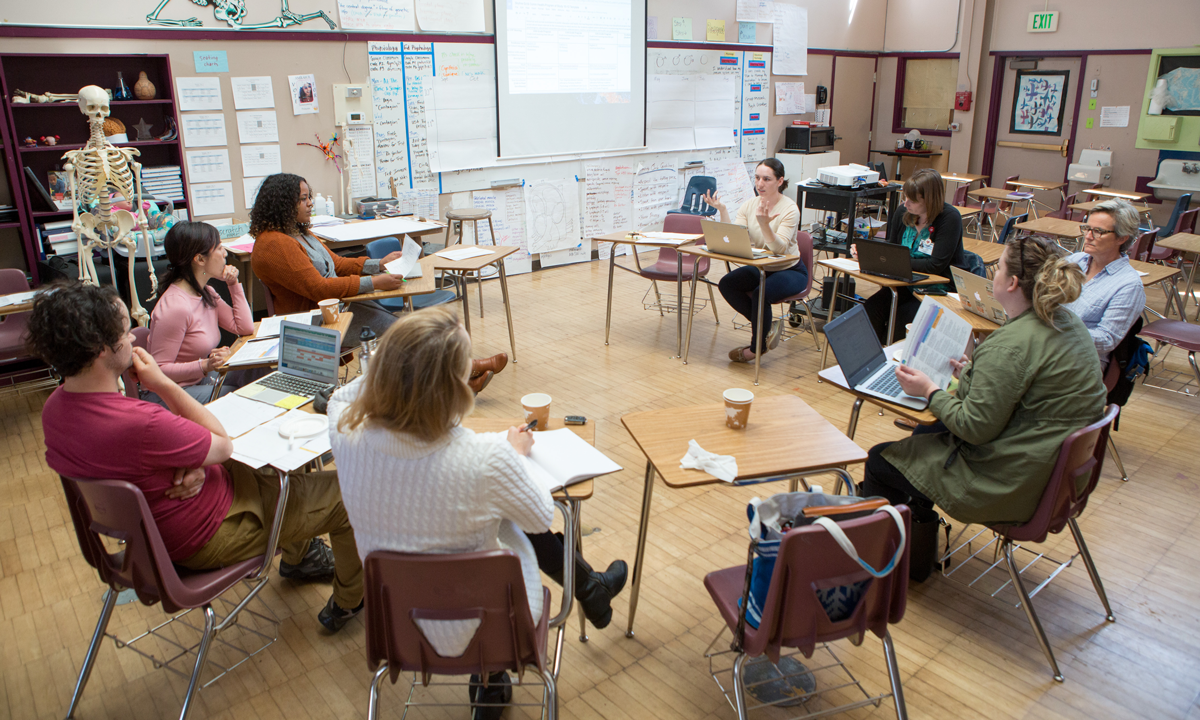How I Coach All Educators at My Baltimore HS to Be Reading & Writing Teachers
O'Brien: The only way to catch older students up is to wrap literacy lessons into every grade and subject. But faculty members must learn how.

Get stories like this delivered straight to your inbox. Sign up for The 74 Newsletter
If you’ve been following education news, you know students’ reading and writing skills remain low, especially after the pandemic, with no state having made gains since 2022. School districts need to do more to ensure every student enters adulthood fully literate. One step is to train all educators — not just those in elementary and English classes — to be reading teachers.
Many states, including Maryland, where I live and work as a literacy coach, are embracing the science of reading, which uses brain science to teach children how to read. However, these efforts are focused at the elementary level, and older students are going through high school without the benefit of these best practices.
My district, Baltimore City Public Schools, is working to address that problem. For the last four years, I have helped all teachers at Reginald F. Lewis High School weave reading and writing into their lessons. This is unusual, because while the district has had literacy coaches in elementary and secondary schools, most work only with English Language Arts teachers. This isn’t enough.
Consider this: During a team meeting, teachers and I reviewed Maryland’s state English test and found it had just one set of questions related to a literature passage. The rest were based on informational texts, such as historical primary source documents, scientific reports and graphs. Subject-matter teachers are best-suited to help students learn to read and analyze these passages.
While all the teachers I work with know that students are coming to them with large literacy gaps, most weren’t accustomed to working with a coach, especially a literacy coach. They were skeptical at first. Overcoming that required taking key steps.
First, my principal had to make it clear that literacy learning was a schoolwide responsibility and that I was there to help. Then, I had to build strong relationships with teachers. I did that by listening, learning about the challenges they faced, observing instruction and providing feedback, and being a consistent and supportive presence in their classrooms. We studied data and set goals together.
It was especially important to be patient. Change of this kind takes more than a single school year.
Across classrooms, we raised the rigor. Because reading achievement was low, teachers had been using texts designed for elementary or middle schoolers. But what our high schoolers needed was reading material aligned to high school expectations. My job was to give teachers tools that they could use to help students understand what they were reading. These included strategies such as previewing complex vocabulary with students before diving into reading and offering multiple opportunities and ways to access difficult texts, such as through read-alouds or partnered reading. Those approaches improve reading fluency and are particularly appropriate when books or articles are challenging.
Yet, even as the teachers helped students to access harder books, they had to pull back on doing too much. I found they were reading aloud texts that students were capable of reading on their own, or oversimplifying assignments and taking away opportunities for students to write answers that showed what they really knew.
Today, the teachers know that I’m there to help their students learn in their particular content area and are proud that, after a sharp dip in proficiency directly after the pandemic, our students have made significant gains in English language arts proficiency. Overall, our school went from 10% English proficiency in 2023 to 27% in 2024, and we met our literacy progress goals for the first time since the pandemic. Teachers also like the engagement they see in their classrooms when students read aloud to their partners or speak up to answer questions.
More recently, after we realized students were skipping written response questions on state assessments, we started weaving writing instruction into the school day. To tackle this, our school made writing instruction the focus of professional development and coaching. We all read “The Writing Revolution,” by Judith Hochman and Natalie Wexler, and I provided support to teachers based on the approach in the book and training I received.
Many teachers at first lacked confidence around teaching components of good writing, so I provided explicit modeling and coaching. In a math class, I’d have a teacher demonstrate what good writing looks like in that grade and subject — for example, writing a response to a question — and then we’d discuss ways to help students reach that level of proficiency.
Today, nearly all teachers in my school are more comfortable providing writing instruction in their content area, and nearly all implement some kind of writing instruction every day. This means that students get multiple chances to practice writing and learn particular skills. I love hearing them saying things like, “All my teachers are talking about segment fragments!” Or, “Now we have to use conjunctions everywhere!”
In January, teachers had reported that half or more of their students skipped writing tasks on any assignment. Today, nearly every student writes answers to assignments, and basic writing mistakes have dwindled.
I’ve also been working to help encourage students to read independently. NAEP survey data show that a mere 14% of 13-year-olds read for enjoyment daily. It’s a shocking figure but it reflects what I see. I often ask students what they like to read, and unfortunately a common answer is, “I don’t know. I don’t really like reading.”
After one of these exchanges, I asked my 10-year-old, who loves curling up with a book, what he would say to that. “I would say they just haven’t found the right book yet!” he replied. High schoolers have tons of interests and opinions; they just need to find a book based on these interests to ignite a love for reading. Sometimes I ask kids what movies they like, and the answer usually helps make a connection to books. I also encourage families to participate in summer library programs that give kids and adults a free book of their choice each month.
I believe the successes my school has seen on classroom tests in literacy will also show in the state exams our students recently took. More importantly, I’m confident the skills they’ve learned will make a lasting difference in their lives, whatever path they choose.
Get stories like these delivered straight to your inbox. Sign up for The 74 Newsletter

;)